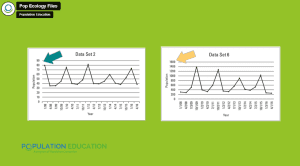There are many limiting factors that can impact population sizes. Most limiting factors are density dependent or density independent.
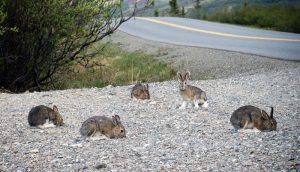
What is a Density Dependent Factor?
With a density dependent factor, the size of a population in an area influences the level of impact. Imagine there are 10 empty water bottles, close together on a table, and you roll a softball towards them. The ball might knock over quite a few of the bottles. Now imagine the bottles are spread out on the table. Rolling a ball will not knock over as many. The softball is density dependent – it hits more bottles when they are close together.
When thinking about limiting factors for ecosystems or living things, density dependent limiting factors are associated with organisms or biotic factors that impact population size.
What is a Density Independent Factor?
Density independent factors impact an individual in the population regardless of how many individuals are in an area. Again imagine 10 water bottles on a table, but this time you shake the table. It doesn’t matter if the bottles are close together or spread out, they’ll all fall over when the table moves. The shaking table is density independent – it hits bottles whether they are close together or not.
In natural ecosystems, density independent limiting factors are associated with non-living things or abiotic factors that impact population size.
How Do Limiting Factors Affect Population Size?
All limiting factors impact carrying capacity, or the number of each type of species an ecosystem can support based on the resources available. An area rich in biodiversity has a better chance of minimizing the impacts of these limiting factors and increases the likelihood of survival because there are a variety of different species to provide for the ecosystem.
Density Dependent Factors Examples
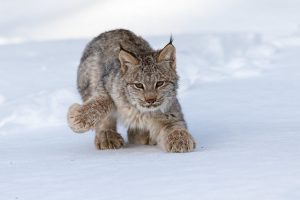 Predation – happens when one animal (the prey) is food for another (the predator). Higher populations of prey could invite more predators to an area which could lead to a boom-bust cycle with a predator/prey relationship in the ecosystem. The relationship between the snowshoe hare and the Canadian lynx is a great example of predation as a limiting factor.
Predation – happens when one animal (the prey) is food for another (the predator). Higher populations of prey could invite more predators to an area which could lead to a boom-bust cycle with a predator/prey relationship in the ecosystem. The relationship between the snowshoe hare and the Canadian lynx is a great example of predation as a limiting factor.
Resources – the availability of a resource influences how many individuals can survive. Depending on the size of the population in an area, there could be more or less food, water, or space for each individual. The amount of resources in an area are a density dependent factor and could eventually lead to an increase or decrease in population size.
Disease and parasitism are density dependent limiting factors because they are able to spread faster in a more dense population. This could lead to higher mortality rates.
Interactions between members of the same species are dependent on the size of a population in an area (i.e. are density dependent). If there are more members of the same species in an area this could increase competition for mates, which could impact reproductive patterns and ultimately, how large the population grows.
Density Independent Factors Examples
Climate and weather events are density independent limiting factors. Events like seasonal temperature changes, hurricanes, droughts, and floods can disrupt resource availability, migration patterns, shelter and so much more. It doesn’t matter how many individuals are in an area’s population; these events will have an impact.
Natural disasters including earthquakes, tsunamis, volcanic eruptions can destroy habitats, and impact the ability to survive in the new habitat, no matter the density of the population.
Habitat alteration and destruction are density independent. Changes in habitat can occur from climate and weather events and natural disasters but often happens from human impacts like deforestation, urbanization, and habitat fragmentation. 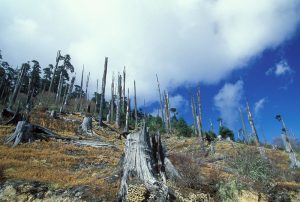
Pollution like pesticides from gardening and agriculture, industrial waste or improperly disposed hazardous materials can harm members of a population whether there is one individual in an area or 100.
How Limiting Factors Interact
Density dependent and density independent limiting factors can interact with each other and have varied effects. For example, because of climate change, a density independent factor, the snowshoe hare is more vulnerable as prey during an increasingly longer period of time where there is no snow. This is causing the populations of the snowshoe hare to decrease over time. The snowshoe hare is prey for the Canadian lynx. As the lynx’s food source decreases, a density dependent factor, this may impact the carrying capacity of the Canadian lynx.
Another interesting example of the interactions between density dependent and independent factors is an example from “Monkey Island.” Much of the habitat of a secluded group of rhesus macaques was destroyed by Hurricane Maria, a density independent factor. Interestingly, the monkeys that have strong social bonds with each other – a density dependent factor because more monkeys means more bonding – are faring better and have “aged less” from the stress the hurricane caused.
Want to dive deeper into population dynamics? Check out this unit for lesson plans and readings on human population dynamics.
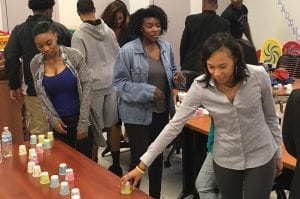
Teachers test out the lesson, Panther Hunt, where students act as panthers and “hunt” for prey to model the concept of habitat carrying capacity.
Image credits: Snowshoe hares in Denali (Snowshoe Hares by Sandy Brown Jensen is licensed under CC BY-SA 2.0); Canadian lynx (Canadian Lynx by Outward_bound is licensed under CC BY-NC-ND 2.0); Deforestation (Deforestation by World Bank Photo Collection is licensed under CC BY-NC-ND 2.0)



